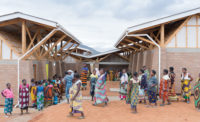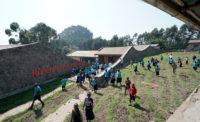In December 2006, while in the throes of a final charrette at Harvard’s Graduate School of Design, first-year student Michael Murphy took a break to attend a speech by the noted humanitarian doctor Paul Farmer. Since 1987, Farmer’s organization, Partners In Health (PIH), has been building medical facilities in impoverished countries such as Haiti and Rwanda. Inspired by the talk, Murphy approached Farmer afterward to ask if he worked with architects. Farmer replied that he didn’t see the need; he sketched his last hospital on a napkin.
“It was kind of an ’aha’ moment,” says Murphy, now 31 years old. “Here’s this internationally recognized nongovernmental organization doing massive infrastructure work. They could snap their fingers and get any architect to work for them for free, and they don’t see the need for professional architectural services.”
The next summer, Murphy secured a fellowship from the architecture firm Hart Howerton to research health care and vernacular architecture in Rwanda. He let PIH know he would be in the area and asked if they needed help. They took him up on the offer, and he spent six weeks working with them on various projects.
Then, that November, Murphy received a life-changing phone call. “Paul called me up and said, ’Do you and any of your friends want to help build a hospital in Rwanda?’ Of course, I said I didn’t know how to build a hospital,” Murphy recalls. At that moment, he was sitting across from fellow student Alan Ricks. “I asked Alan, ’Want to help build a hospital?’” Murphy laughs. “That’s how it started.”
The two signed on as volunteers and soon after founded the nonprofit architecture firm MASS Design Group with several classmates. After working three years on the project, both remotely and on-site, the firm completed Butaro Hospital in January. Built for $4.4 million, the hospital is the first of its kind in the Burera District, a mountainous area in the rural northern reaches of Rwanda.
Perched on a hilltop on the site of a former military base, the 65,000-square-foot complex comprises a series of low-slung, white concrete buildings with terra-cotta tile roofs. The 155-bed hospital has four wards—men’s, women’s, maternity, and pediatric—plus a central building that contains emergency and operating rooms, intensive and postoperative care units, consultation rooms, a pharmacy, and a lab.
The design capitalizes on the hospital’s picturesque setting, with buildings organized around interior landscaped courtyards and, on the perimeter, terraces that overlook the lush valley below. Colorful signage by Massimo Vignelli and Beatriz Cifuentes, well-known graphic designers who volunteered their services, helps visitors navigate the campus.
The benefits of involving MASS are manifold. The project is an exemplar of sustainable architecture, using local materials and labor and employing passive ventilation strategies that mitigate the spread of infectious disease. Moreover, Butaro Hospital’s decidedly non-napkin-sketched appearance jibes with Farmer’s philosophy of dignified construction for the underserved. In a sign of how the hospital has become a point of pride for the country, Rwandan president Paul Kagame attended its inauguration ceremony.
Such an event would have been impossible 17 years ago, when Rwanda was embroiled in a brutal genocide. Over the course of 100 days in 1994, the Hutus, the country’s majority group, slaughtered an estimated 500,000 to one million minority Tutsis. Fortunately, the small East African country (roughly the size of Maryland) has made great strides since then. Thanks to its stabilized government and roaring economy, Rwanda ranked second in the World Bank’s 2011 list of most-improved economies for favorable business conditions. Tourists have also returned in droves to the temperate, high-altitude nation that is characterized by lakes, verdant topography, and exotic wildlife.
Systemic problems persist, however, in the most densely populated African country. More than half of Rwanda’s 9.7 million residents live in poverty, and life expectancy is a mere 58 years. In addition to sub-Saharan Africa’s ongoing HIV/AIDS epidemic, Rwanda has the 16th-highest global tuberculosis (TB) rate, according to the World Health Organization, with about one out of every 177 people infected.
At the invitation of the government, PIH began working in Rwanda in 2005, aiming to boost its health-care system through various means. The following year, a Clinton Foundation study helped determine that the Burera District (pop. 340,000) had the worst health status in the nation, as it had no hospitals nor doctors. It was a logical place for PIH, in partnership with the Rwandan health ministry, to construct a new hospital.
When conceiving the design for Butaro, the starting point for MASS was creating a highly ventilated environment to mitigate the spread of airborne diseases, such as TB. The team accomplished this through several approaches. For starters, they did away with the traditional double-loaded, unventilated corridor, where people congregate and germs fester. Instead, they created more open spaces and used outdoor passageways to link buildings. Rooms also contain numerous operable windows on opposite walls to promote cross-ventilation and take advantage of winds from the site’s hilltop location. Moreover, 24-foot-diameter fans turn in reverse and pull air upward. According to early tests, these ventilation tactics are producing 12 air changes per hour. Ultraviolet germicidal irradiation lighting further sanitizes the atmosphere.
To improve patient morale, MASS inverted the typical hospital ward, where beds face inward. “If I’m a patient who is really sick, why would I want to lie in a bed and look at other sick patients?” asks Murphy. The team placed a low-lying partition in the center of the room and lined it with beds facing windows, offering patients a view of the outdoors.
Equal attention was paid to the hospital’s construction. Rather than bring in expensive heavy equipment and professional laborers, MASS and PIH, which served as contractor, trained and paid nearly 3,900 area residents to excavate the site and build the facility with mostly local materials. Labor was divided among six teams, each working two-week shifts, to enable six times the employment. “It was important to get the community invested in this project,” says 28-year-old Ricks. “Ultimately, they’ll be the ones responsible for its long-term success.”
The workers acquired valuable skills during the project. For instance, the architects wanted to clad several exterior walls with local volcanic rock. TExterior circulationhey trained masons on how to build walls using very little mortar to create a more natural appearance and take advantage of the rock’s inherent beauty. “They became so skilled by the end that they asked if they could tear down the first wall and rebuild it,” Murphy says (they did). “Now they have this incredible skill and are highly sought after in the country.”
Indeed, aesthetics were considered to a degree not often found in utilitarian projects, let alone humanitarian ones. A cornerstone of the PIH philosophy is that buildings for impoverished communities should be no less visually appealing than those for the privileged. Peter Drobac, a doctor and director of PIH’s Rwanda program, says residents were in disbelief when they saw the initial plans for Butaro Hospital. “People were first shocked—then they cried,” he says. “They thought it must be a hotel for Westerners.” The architecture is “striking,” he notes. “This is not a hospital for Americans or Rwandan elite,” he continues. “It’s a public facility for the rural poor; it makes a statement.”
The Butaro project has spawned other humanitarian work for MASS in Haiti as well as in Rwanda, where they just completed a primary school for the Girubuntu Association, a local nonprofit group dedicated to education. MASS has gained renown domestically as well: Cincinnati Children’s Hospital hired the firm to do research in preparation for a major expansion of its cerebral palsy program. Oh, and Murphy and Ricks both received their degrees from Harvard.
The experience with MASS converted PIH, who now acknowledges the power of design professionals—particularly those committed to social justice. “The added value provided by MASS was tremendous,” Drobac says. “They’re like the PIH of architects.”











Post a comment to this article
Report Abusive Comment